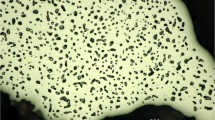Abstract
The paper gives an account of a new type of orthorhombic pyroxene recently discovered in the biotite-cordierite-hypersthene granulites occurring near the village Bidaloti in Mysore. From a detailed study of this mineral from the physical, chemical, and optical points of view, it has been shown that this orthopyroxene has a distinct individuality of its own, distinct from the known members of the enstatite-hypersthene series, and must therefore be recognised as a new mineral. It has also been shown that this pyroxene is of unusual origin, being derived from cordierite. The authors propose to call this new mineralBidalotite after the village near which it was first found.
Similar content being viewed by others
References
B. Rama Rao and M. B. R. Rao,Curr. Sci., 1934, 3, 114–15.
B. Rama Rao,Proc. 23rd Ind. Sci. Congress, 1936, 233.
W. F. Smeeth,Bull. Dept. of Mines and Geol, Mysore State, 1916,6, 17–18.
A. W. Groves,Q. J. G. S., 1935,91, Pt. 2, 155–57.
Rights and permissions
About this article
Cite this article
Rao, B.R., Rao, L.R. On “Bidalotite”, a new orthorhombic pyroxene derived from cordierite. Proc. Indian Acad. Sci. 5, 290–296 (1937). https://doi.org/10.1007/BF03048189
Received:
Issue Date:
DOI: https://doi.org/10.1007/BF03048189



